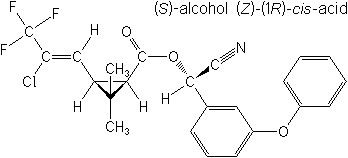Pesticides >> Insecticide>> Cyhalothrin
Cyhalothrin
Cyhalothrin 95%TC
Cyhalothrin 25%EC
Insecticide
pyrethroid

NOMENCLATURE
Common name cyhalothrin (BSI, draft E-ISO, BAN); cyhalothrine ((f)
draft F-ISO)
IUPAC name (RS)-a-cyano-3-phenoxybenzyl (Z)-(1RS,3RS)-3-(2-chloro-3,3,3-trifluoroprop-1-enyl)-2,2-dimethylcyclopropanecarboxylate
Roth: (RS)-a-cyano-3-phenoxybenzyl (Z)-(1RS)-cis-3-(2-chloro-3,3,3-trifluoropropenyl)-2,2-dimethylcyclopropanecarboxylate
Chemical Abstracts name [1a,3a(Z)]-(?-cyano-(3-phenoxyphenyl)methyl
3-(2-chloro-3,3,3-trifluoro-1-propenyl)-2,2-dimethylcyclopropanecarboxylate
CAS RN [68085-85-8] Development codes PP563; ICI 146 814 (both ICI)
Official codes OMS 2011
Cyhalothrin APPLICATIONS
Mode of action Non-systemic insecticide with contact and stomach
action, and repellent properties. Gives rapid knockdown and long
residual activity. Uses Control of animal ectoparasites, especially
Boophilus microplus and Haematobia irritans on cattle, and Bovicola
ovis, Linognathus spp. and Melophagus ovinus on sheep. Applied as
an animal dip or as a spray around animal houses. Formulation types
EC; WP. Selected tradenames: 'Cyhalon' (Syngenta); 'Grenade' (Syngenta)
ANALYSIS
Product analysis of pyrethroids reviewed by E. Papadopoulou-Mourkidou
in Comp. Analyt. Profiles. By hplc (A. Jacques et al., Anal. Methods
Pestic. Plant Growth Regul., 1984, 13, 9). Residues determined by
glc with ECD (idem, ibid.). Details available from Syngenta.
MAMMALIAN TOXICOLOGY
Reviews JECFA 54, FAO/WHO 42, 43 (see part 2 of the Bibliography).
Oral Acute oral LD50 for male rats 166, female rats 114, guinea
pigs >5000, rabbits >1000 mg/kg. Skin and eye Acute percutaneous
LD50 for male rats 1000-2500, female rats 200-2500, rabbits >2500
mg/kg. Moderate eye irritant; not a skin irritant (rabbits). Moderate
skin sensitiser (guinea pigs). Inhalation LC50 (4 h) for rats >0.086
mg/l. NOEL No significant toxicological effect observed in feeding
trials with rats (2 y) or dogs (0.5 y) at 2.5 mg/kg daily. ADI (JECFA)
0.002 mg/kg b.w. (temporary) [2000]; (JMPR) 0.02 mg/kg b.w. [1984].
Other No evidence of carcinogenicity, mutagenicity or disturbed
reproductive functions; no adverse effects on foetal development.
A facial sensation may be experienced by users of the chemical;
this is transient, with complete recovery. Toxicity class WHO (a.i.)
II
ECOTOXICOLOGY
Birds Acute oral LD50 for mallard ducks >5000 mg/kg. Fish LC50
(96 h) for rainbow trout 0.00054 mg/l. Daphnia LC50 (48 h) 0.38
mg/l.
ENVIRONMENTAL FATE
EHC 99 (WHO, 1990). Animals In rats, following oral administration,
cyhalothrin is rapidly eliminated in urine and faeces. The ester
group is hydrolysed, both moieties forming polar conjugates. Soil/Environment
In soil, DT50 c. 4-12 weeks. Leaching of cyhalothrin and its degradation
products through a range of soil types is negligible.